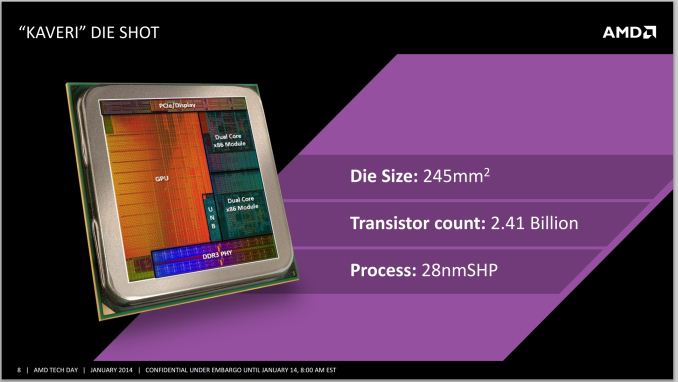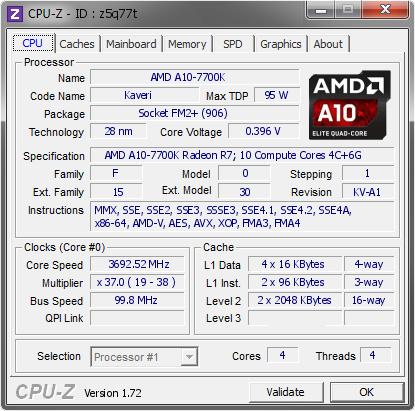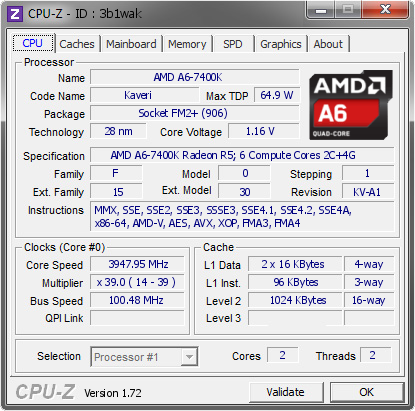The AMD A10-7700K and AMD A6-7400K CPU Mini-Review
by Ian Cutress on May 27, 2015 9:00 AM ESTAMD A10-7700K and AMD A6-7400K Conclusion
I started this mini-review stating that the question of the number of processors that both Intel and AMD produce all seem to differ by 100 MHz and $7, and that I had received questions as to why this is the case. Ultimately a lot of recommendations for computer components start to revolve around ‘Well for $10 more, you could get this’, and at some point you are considering something that costs $50 more. There has to be a point where you stop, especially if an IT department or system builder wants to go through and develop 200+ machines in a month.
Intel and AMD currently have different approaches to this. Intel likes to launch a big part of its stack all at once. Sometimes it will launch individual units outside this, or it will start a new line-up with one or two units then introduce the bulk later. With Haswell for example, on the socketed CPU space, we have 50 different CPUs varying in price, power, frequency, core count, threading and integrated graphics. Imagine the poor reviewer that has to test them all (insert here that I’d love to test them to get all the data, if I had time and could source them)!
AMD’s approach to Kaveri is to dribble rather than gush. Rather than overload the user base (both end-users and commercial) with a large haystack of parts, they launched two or three SKUs on day one, then one or two every 6-12 weeks since. This has some benefits, namely the improvement of the production process over time, the repeated opportunities to market new products and the opportunity to re-educate potential clients through the media. The downside of this strategy is one similar to starting with Swiss cheese and then filling in the holes – if a client wants a SKU with particular characteristics but the company does not have it, then they will go look for something else and take their money with them. It’s a method that acts as a double edged sword.
As AnandTech’s CPU editor, I get to play with a lot more SKUs than most. This means both the big shiny halo products, such as the 8-core goliaths, but also some of the higher volume dual core stuff which is more in line with a budget PC or mass PC build. With AMD’s strategy, as they have fewer processors overall, our coverage can be a little more complete than the others. AMD sampled us both the A10-7700K and the A6-7400K for this purpose, and we hope to work closely with them for future launches and get the best comparison list of their product stack.
Back to the SKUs tested for this mini-review, we can tell that the A10-7700K keeps up with the other A10 parts in our CPU testing, but as it has two fewer compute units in the integrated graphics it can lag behind a little and is more in line with the A8 processors in that regard, essentially making it more of a hybrid part. The A6-7400K fits into that budget CPU line at $64, and the results show this in both our CPU and GPU testing. The single module performs well enough in single threaded environments, but doesn’t have enough legs for the big tasks and can be swamped easily. Despite having two threads, the Bulldozer based design still has single-threaded like behavior in some tests. That being said, the graphics tests are a mixed bag. For titles that can use more threads, I can’t help but feel that it is a little held back, even at 256 SPs. For other titles, it performs on par with other processors almost double its price. Dual Graphics mode unfortunately was not possible with the A6, and it was also noticeable that some games (Shadows of Mordor in particular) took longer to load with only one module.
To say AMD’s APUs are like marmite (you either love them or hate them) is to gloss over a more complex issue. AMD’s design has its plus points and its negative points, a fact that AMD marketing knows when I speak to them. Nevertheless, they have to focus on the plus points, which include gaming at equivalent price points, DX12 support, OpenCL performance and moving forward with HSA. Using the right tool for the right job should now be considered a cliché, but it rings true when it comes to technology and more so than ever when innovative methods are continually being fashioned. Based on AMD’s Financial Analyst Day and their recent exposure into HBM (I highly suggest reading Ryan’s awesome writeup on it), I can safely say that I want to see an APU with HBM in the future. Despite the inevitability that AMD already know that people want one, I told them anyway. We will have to wait and see.














105 Comments
View All Comments
Edens_Remorse - Wednesday, May 27, 2015 - link
8370e($120) + ASRock 970M Pro 3 mATX($15... yes $15) and a Raijintek Pallas CPU cooler($33) is an absolute monster combination that will only get better with dx12. Show me a combination that comes close to that performance for anywhere near the price. I loved my 4790k, but appreciating what one has in no excuse for ignorance.azazel1024 - Wednesday, May 27, 2015 - link
Which may be a long time in coming. I look forward to it, but with GPUs being limited to 4GB in the first itteration, that is a heck of a limitation for system RAM. Once 8 or 16GB is possible, it seems more realistic...but also going to be a thwacking expensive chip. Maybe it'll be cheaper than if you bought RAM and CPU seperately...but you can hang on to that RAM for a couple of CPU/board upgrades and with HBM, you have to replace it each time.For a replacable SoC/CPU, I think your best bet is better L3/SRAM and leave the memory slotted. Even when considering iGPUs. Soldered SoC/CPU HBM may make sense.
extide - Wednesday, May 27, 2015 - link
I would bet that an APU with HBM will also have DDR3/4 -- it would use it as like an L3/L4 cache, or maybe only use it for graphics.Refuge - Wednesday, May 27, 2015 - link
HBM isn't going to come to APU's for a few more years at least.Not from AMD that is, although, with how they tend to re-badge and reuse, you may still get your wish to see a Zen core with HBM... lol
Gc - Wednesday, May 27, 2015 - link
Ian, NPB scores beg for an explanation or a correction.Edens_Remorse - Wednesday, May 27, 2015 - link
Why are you reviewing old tech when the new model comes out tomorrow?shadowjk - Wednesday, May 27, 2015 - link
Even if it comed out tomorrow, it will be months before most people can actually buy it, by which time there's something else that's coming out "tomorrow". Reviews of actual products, that can actually be bought, is useful for anyone about to buy a new cpu/apu.Of course, in an ideal world, these would have been benchmarked earlier. Better late than never, I guess..
Edens_Remorse - Wednesday, May 27, 2015 - link
False. You can buy the 7870k today. It even runs on some previous generation FM2+ mobos. Visit cpu-world if you don't want to take my word for it. There are also multiple motherboard manufacturers with new boards specifically for Godavari. This article is completely suspect.ToTTenTranz - Wednesday, May 27, 2015 - link
Why do you blatantly refuse to put up a single Mantle-enabled game to see how lower-performance CPUs (like the ones reviewed) fare in it, as a preview of what to expect in DX12 and Vulkan?And where are the results with dual-graphics turned on for the A10 7700K?
You mention dual-graphics in the first page and the conclusion, but are they turned on in the gaming results?
There's no comparison with the 7700K with and without dual-graphics turned on? It didn't work at all? I don't get it.
Yes, Intel CPUs fare better in DX11 and AMD CPUs using discrete graphics cards. We know.
We've known that for years.
Now we know it hasn't changed, ever since the last guy who made the exact same tests on the exact same (non-Mantle, non-Crossfired) conditions, which was probably last week or something.
I love Anandtech, but this review is useless the way it's done, Ian.
Guspaz - Wednesday, May 27, 2015 - link
Mantle is a dead API (having been supplanted by DX12 and Vulkan) that is only supported by a handful of games... It doesn't make sense to revamp their benchmark suite just to test on something that has limited utility and no future.